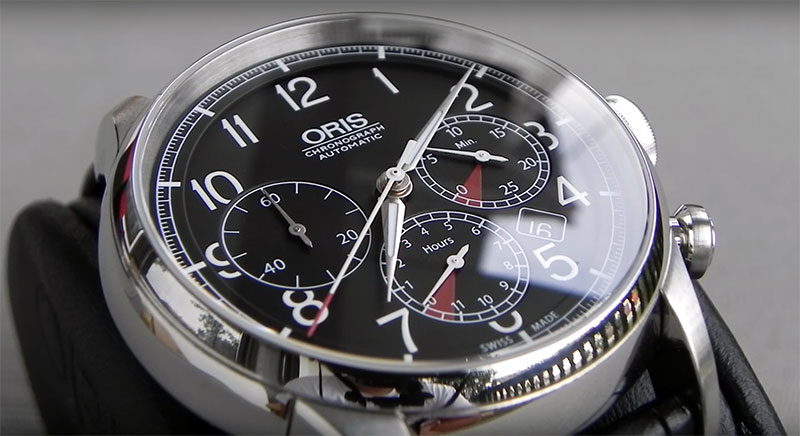Today, I’ll be doing a review of an Oris Raid Chronograph. But first, I would like to thank Ed Marshall Jewelers for supplying this watch, and if you want to check them out, you can click on the link.
Oris RAID Chronograph 2010 LE watch was released in 2010 in a limited run of only 500 pieces for the whole world. It has become an annual model that Oris does as the official timekeeper of the Raid Rally which is an old-timer rally that goes from Basel to Paris and includes cars built before 1975. Each year, Oris releases a model to commemorate the event.

RAID watches, the 2010 model, is my favorite. The reasons I like it so much are the chronograph subdials with the shift at zero position and the red portion of the dial which is a tribute to one of the best-looking cars of all time, the Jaguar XK120. This asymmetric look really draws your eyes to the tile and makes the watch a great conversation starter.
The other reasons for me liking it so much is the style of everything on this watch. The tile, the case shape, and finish, even the pushers, and crown, all give a feel and look of gauges and switches from vintage sports cars. It’s not like they just slammed the vintage-inspired dial to a generic case, but everything looks well-thought-out.
Specifications

| Diameter: | 43,7 mm |
| Lug to Lug: | 50,8 mm |
| Thickness: | 15,2 mm |
| Weight: | 120 g |
| WR: | 30m |
| Crystal: | Sapphire+AR |
| Movement: | 676-ETA7753 |
| Price: | $2000-4000 |
When it comes to the specs, the watch is large with the diameter of just under 44 millimeters. A lug of almost 51 and the thickness of more than 15 millimeters, these dimensions make it sound like a very large watch in every way. But somehow even on my 6.9-inch wrist, it wears surprisingly well. The long lug has a shorter look, thanks to a very steep slope of the lugs. The watch somehow appears thinner than the measured 15 millimeters. I think that is down to the way the whole case is bowl-shaped, so the sides are not that pronounced like on slab-sided watches.
- The whole case is highly polished, with only the top of the lugs having an eye satin-finish.
- The overall level of fit and finish is incredibly well executed; something worse seems to be doing well.
- All the polished surfaces have a perfect mirror finish with no distortions visible, and a transition to the satin finish is crisp and clean.
- The watch comes on a very nice leather strap and an even nicer deploying buckle that is milled and highly polished to match the case.
- The inner part of the buckle features per lodge finish, which is a nice touch.
- The strap itself is very comfortable and not overly long, which is something I like.
It works by tucking the excess piece of strap on the inside meaning there are no additional keepers that you need to put it in. And there will be nothing sticking out if you have a really small wrist.
The crystal is double domed sapphire with anti-reflective coating on the inside only, which is how I prefer it. But please note that the dome is so small that the crystal appears almost flat. Some might desire a bigger dome, but this lower doesn’t make the watch incredibly legible while still giving it some character. Underneath the crystal is the dial, and to me, this is the best part of this watch.
As I mentioned at the beginning, the chronograph subdials have been inspired by the Jaguar XK120, but not only by the color scheme and the position of the red portion. The railway track markers and even the font used is almost identical to the ones used in the car.
The shifted zero position of the chronograph hands are very cool, and as I said, it really draws your eyes to the dial, especially in combination with the red section. The dial itself is matte black and very legible.
The numerals are large and thin, which makes them very readable. The same goes for all the hands that are thin, properly long, and reach their designated markers.
If you read my articles, you know I’m a sucker for color coding or separation of different functions by using different colors on the hands. Although at first, it might seem like this watch uses the same color for all the hands; however, upon taking a closer look, you will discover that it isn’t so.

The main time, meaning the hour, minute, and seconds hands are made in some kind of frosted silver finish; very unique looking and very nice. While all the chronograph hands are in plain white, the difference is very subtle, but it’s there, making the chronograph stand out just slightly more. I also like the proportions as the sub-tiles are just right in terms of position and size relative to the dial.
The watch does feature a loom, although it’s applied in such a small amount that it struggles to be visible all night. But to be honest, even if it lacked loom altogether, I really wouldn’t mind it as the beauty of the dial makes up for it.
The watch doesn’t feature an exhibition case back even though it is found pretty often on our swatches. Here, we have a solid case back with all the engravings regarding the commemoration of the raid rally. The case back is also not the usual screw back, but it’s held by eight small screws which shouldn’t be a problem since the watch is rated to only thirty meters of water resistance. Underneath the case back beats the Auris 676 movement, which is a modified ETA 7753, and that explains the thickness of more than fifteen millimeters. It beats at 28800 beats per hour, comes with twenty-seven jewels and has a power reserve of 48 hours.
Functions
When it comes to functions, it has hours, minutes, seconds, a 12-hour chronograph, and date function. The date is changed by pressing this recessed button at 10 o’clock, so the crown has only one click. The chronograph feels like any cam actuated chronograph, meaning the start and reset are harder to push than the stop.
Conclusion
In conclusion, this is a very well executed vintage car inspired racing chronograph that to me at least takes all the right boxes. The raid chronographs are no longer produced and ended, I believe in 2013. This 2010 model like I already said is the best of the breed as it has the most balanced dial and also uses an ETA based movement while later iterations use a Salida, which some might find inferior to this. Since these were limited to only 500 pieces, the used market is the only place to hunt one down. Their prices are pretty reasonable considering how unique they are and the fact they come with impeccable fit and finish that we have come to expect from Morris. I think this is one of the rare watches where I have nothing bad to say about it except my usual size nagging as I would love to see this in a thirty-nine to forty-millimeter case.
This pretty much completes this week’s review, so thank you for reading, I hope you enjoyed.

 Amber Jewelry
Amber Jewelry